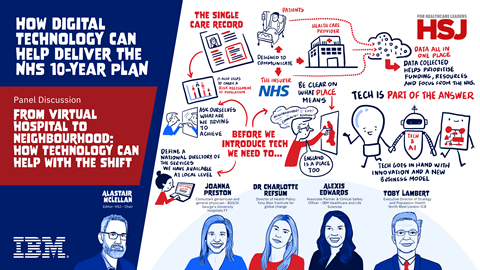Digital technology has a big part to play in helping the NHS deliver the ambitions of the forthcoming 10-year plan and address immediate operational pressures, such as the need to reduce waiting times to access elective care. The 3 December HSJ summit, in association with IBM, looked at how this could happen and what role AI might have in it.
In association with
Care moving closer to home has been an NHS mantra for many years, but progress has been limited and often not linked to financial flows. Technology, however, could prove a turning point, the last panel of the summit heard.
Tony Blair Institute for Global Change director of health policy, Charlotte Refsum, said the government’s proposed shift from hospital to community would need underpinning by the shift from analogue to digital – in particular, through digital health records which centred health data around the citizen, rather than the organisation. Primary care services needed to reflect risk stratification, she added, and allow different types of care to be offered to some patients.
Central to this is integrated neighbourhood teams using a shared health record, she added. “You can start to navigate entirely digital pathways of care with digital health records and that’s what… is the gamechanger,” she said.
Good care navigation and a directory of services would be crucial to empowering patients to access digital pathways, said Alexis Edwards, associate partner and clinical safety officer at IBM. As well as population health management, a care orchestration layer which supported multidisciplinary teams to collaborate could provide a “longitudinal view… of patients within the community, but then also empower the clinicians who are working with them to have greater visibility, to reduce duplication of efforts [and] provide better logistics management, asset management [and] field dispatch to really empower that neighbourhood”.
Some areas have come closer than others to having digital care records which provide a full view of patients’ interactions with the NHS. North West London Integrated Care Board executive director of strategy and population health, Toby Lambert, said his area had a system which brought together secondary, primary, and community health as well as adult social care data.
“In theory, you can look at it and see all of the activity, all of the diagnosis and, indeed, the cost for any individual patient in north west London,” he said.
However, he stressed the shared record alone was not the whole answer, adding an analytical layer on top to give useful insights was also required.

Meanwhile, Joanna Preston, a geriatrician from St George’s University Hospitals Foundation Trust and a British Geriatrics Society member, said: “The key thing is if we can get this right for older adults, it’ll be right for the NHS.”
She challenged the view that older adults can’t use digital tech, saying one patient had pointed out to her that their generation had designed the tech. However, design and safeguards needed to reflect heterogeneity among older people, including cognitive, sensory, and physical impairments, she said.
Virtual wards – which use technology to remotely monitor someone – tended to exclude some older adults who were less clinically straightforward, she pointed out. These were a group who were very vulnerable to poverty, loneliness, and social exclusion, where maintaining relationships was important.
Dr Preston pointed to the existing comprehensive geriatric assessment framework as an example of a successful process using a defined dataset. Technology might also help to cut the time needed for assessments, she said, making it quicker to bring together information to inform clinical decisions.
This is the second to last article from the summit – one more is due to run next week.
You can learn more about IBM’s viewpoint on digitally-enabled neighbourhood-based care in its recently published paper: https://ibm.biz/digitallyenabledneighbourhoods2025
How AI could make dashboards redundant within the next 10 years
- 1
- 2
- 3
- 4
 Currently reading
Currently readingCould tech be what finally enables the shift to community?
- 5






























